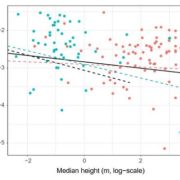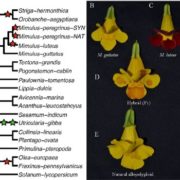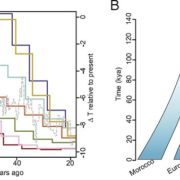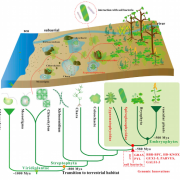Pseudogenization and resurrection of a speciation gene (Curr. Biol)
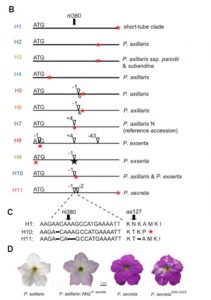 Many flowers have evolved to attract pollinators through scent, shape, nectar production and color. Small changes in any of these attributes can be sufficient to dramatically shift pollinator preferences and pollination efficiency. Petunia has recently diverged into several species, characterized as short- or long-tube forms. Short tube forms are purple and bee-polinated, whereas there is more diversity in the long-tube forms. Petunia axillaris is a white long-tube form, pollinated by hawk moths, and with a loss-of function single nucleotide deletion in a gene encoding the AN2 transcription factor involved in expression of pigment genes. Another long-tube form Petunia secreta, is purple. Using phylogenetic reconstructions, sequence comparisons, and functional analyses, Esfeld et al. showed that P. secreta is derived from P. axillaris by an additional two-nucleotide deletion in the gene encoding AN2, restoring the proper reading frame and thus a functional protein (and pigmentation). Thus, they have demonstrated the rather improbably resurrection of a key speciation gene. (Summary by Mary Williams) Curr. Biol. 10.1016/j.cub.2018.10.019
Many flowers have evolved to attract pollinators through scent, shape, nectar production and color. Small changes in any of these attributes can be sufficient to dramatically shift pollinator preferences and pollination efficiency. Petunia has recently diverged into several species, characterized as short- or long-tube forms. Short tube forms are purple and bee-polinated, whereas there is more diversity in the long-tube forms. Petunia axillaris is a white long-tube form, pollinated by hawk moths, and with a loss-of function single nucleotide deletion in a gene encoding the AN2 transcription factor involved in expression of pigment genes. Another long-tube form Petunia secreta, is purple. Using phylogenetic reconstructions, sequence comparisons, and functional analyses, Esfeld et al. showed that P. secreta is derived from P. axillaris by an additional two-nucleotide deletion in the gene encoding AN2, restoring the proper reading frame and thus a functional protein (and pigmentation). Thus, they have demonstrated the rather improbably resurrection of a key speciation gene. (Summary by Mary Williams) Curr. Biol. 10.1016/j.cub.2018.10.019



